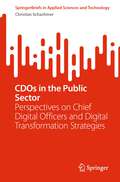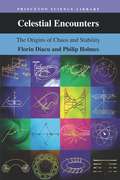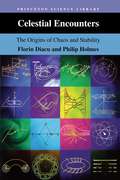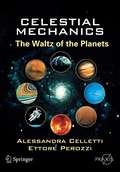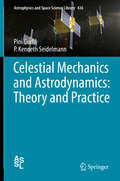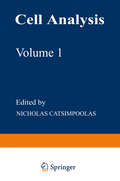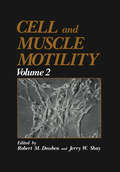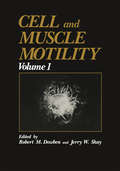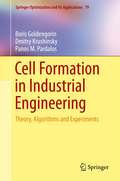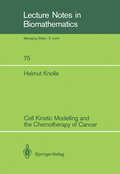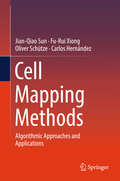- Table View
- List View
CCEA GCSE Mathematics Foundation Practice Book (2nd Edition) (PDF)
by Linda Liggett Robin LiggettExam Board: CCEALevel: GCSESubject: MathematicsFirst Teaching: September 2017First Exam: Summer 2019Provide structured support and extra practice with hundreds of practice questions that focus on problem-solving, building the exam skills needed to succeed in the new GCSE specifications. - Enhance learning and build exam skills with extra practice designed to support the student books- Help develop students' skills and prepare them effectively for their exam with questions that cover all units of the new syllabus- Build problem-solving and mathematical reasoning skills with a range of practice questions
CCEA GCSE Mathematics Higher (2nd Edition) (PDF)
by Neill Hamilton Anne ConnollyBuild all the necessary skills to progress your students' learning and develop their problem-solving skills with this fully updated edition of the market-leading Student's Book for CCEA GCSE Mathematics. - Supports you and your students through the new specifications with content mapped to the new module options with material for each module (M1/M5, M2/M6 F or M3/M7 and M4/M8 H) clearly indicated throughout. - Prepares students for assessment with plenty of practice questions divided into calculator and non-calculator, plus links to further relevant and appropriate exam questions.- Develops understanding with Learning Objectives and required knowledge set out at the start of each chapter.- Tests understanding with end of chapter exercises and problem-solving questions throughout. - Enhances learning with detailed worked examples and solutions.
CCEA GCSE Mathematics Higher Practice Book (2nd Edition) (PDF)
by Anne Connolly Linda Liggett Robin LiggettExam Board: CCEALevel: GCSESubject: MathematicsFirst Teaching: September 2017First Exam: June 2019Provide structured support and extra practice with hundreds of practice questions that focus on problem-solving, building the exam skills needed to succeed in the new GCSE specifications. - Enhance learning and build exam skills with extra practice designed to support the student books- Help develop students' skills and prepare them effectively for their exam with questions that cover all units of the new syllabus- Build problem-solving and mathematical reasoning skills with a range of practice questions
CCEA GCSE Maths Exam Practice Workbook: Foundation
by CgpBursting with exam-style practice, this write-in CGP Workbook is the ideal way to prepare for the Foundation Tier CCEA GCSE Maths exams (units M1, M2, M5 and M6). The material is stamped to help students prepare for the unit exam they're sitting, plus we've scattered helpful exam practice tips throughout the book. There are worked answers at the back of the book, and some of the trickier questions have guided working so students know how to tackle them. For CCEA GCSE Maths Foundation Tier study notes, don't miss CGP's matching Revision Guide (9781789085631).
CCEA GCSE Maths Revision Guide: Foundation (with Online Edition)
by Cgp BooksThere's no better way to learn the Foundation Tier CCEA GCSE Maths course than with this brilliant CGP Revision Guide. It's bursting with student-friendly study notes (covering units M1, M2, M5 and M6) and helpful worked examples. Students can put their knowledge to the test with exam-practice questions on every page - including short answers at the back of the book, and full step-by-step answers via the free Online Edition. When the book arrives, just use the unique code printed inside the cover to gain full access on a PC, Mac or tablet. To make sure they're fully prepared for exam day don't miss CGP's CCEA GCSE Maths Foundation Tier Exam Practice Workbook (9781789085655).
CCEA GCSE Maths Revision Guide: Higher (with Online Edition)
by CgpThis superb CGP Revision Guide for CCEA GCSE Maths is bursting with crystal-clear study notes and worked examples to help students prepare for any of the Higher Tier exams (M3, M4, M7 or M8). Students can put their knowledge to the test with exam-practice questions on every page - including short answers at the back of the book, and full step-by-step answers via the free Online Edition. When the book arrives, just use the unique code printed inside the cover to gain full access on a PC, Mac or tablet. To make sure they're fully prepared for exam day don't miss CGP's CCEA GCSE Maths Higher Tier Exam Practice Workbook (9781789085648).
CCEA Higher GCSE Mathematics: (PDF)
by Anne Connolly Neill HamiltonThis book covers the complete Higher GCSE Mathematics course for years 11 and 12. Each chapter begins with Learning Objectives and pre-requisite knowledge. There are worked examples and full and clear explanations as well as teaching and learning tips throughout. Non-calculator and calculator questions are clearly indicated. Each chapter ends with a 'You should know' list of what has been covered in that chapter, and a summary exercise, as well as past exam questions.
CCNA Cyber Ops SECOPS - Certification Guide 210-255: Learn The Skills To Pass The 210-255 Certification Exam And Become A Competent Secops Associate
by Andrew ChuCyber-attacks, in their various forms, are increasing in frequency and complexity, causing potential losses to organizations. This book equips readers with the skills required to succeed at 210-255 SECOPS exam, and for those re-sitting, to understand their score report and quickly identify the appropriate sections to concentrate on.
CDOs in the Public Sector: Perspectives on Chief Digital Officers and Digital Transformation Strategies (SpringerBriefs in Applied Sciences and Technology)
by Christian SchachtnerThis book explores the need for innovative approaches to administrative digitization, leveraging technologies such as AI, blockchain, and smart processes to meet citizens' expectations, with a particular focus on the role of Chief Digital Officers (CDOs) in driving successful digital transformations within public institutions. Administrative digitization requires fresh inputs to match the leaps seen in the industry sector, utilizing technologies like AI-driven automation, blockchain transactions, and security tools. Smart process solutions are seen as transformative in upholding service standards aligned with citizens' state expectations. Unlike commercial companies, collaboration offers those overseeing public sector digitization enhanced scaling opportunities by drawing from experiences in other regions and metropolises, directly applicable and reusable. In the public realm, digital strategies mirror legal and social conditions, necessitating adjustments and adaptation options for Chief Digital Officers as they lead digital transformation. Methodological focal points in task structure redesign, process optimization, and motivating actors yield diverse action areas for the CDO's new role in public institutions. This book explores the instruments, strategies, and attitudes necessary to successfully implement transformative initiatives in organizations, emphasizing proven concepts with practical applicability, enabling readers to derive their own interaction options as digital guidance leaders. The book is a concise introduction to the specific requirements for visionary designers driving dynamic changes in user-centric public services.
Cech and Steenrod Homotopy Theories with Applications to Geometric Topology (Lecture Notes in Mathematics #542)
by D. A. Edwards H. M. HastingsCech Cohomological Dimensions for Commutative Rings (Lecture Notes in Mathematics #147)
by D. E. DobbsA Celebration of Mathematical Modeling: The Joseph B. Keller Anniversary Volume
by Dan Czamanski Marcus J. Grote George PapanicolaouThisvolumecelebratestheeightiethbirthdayofJosephB. Keller. The authors who contributed to this volume belong to what can be called the “Keller school of applied mathematics. ” They are former students, postdoctoral fellows and visiting scientists who have collaborated with Joe (some of them still do) during his long career. They all look at Joe as their ultimate (role) model. JoeKeller’sdistinguishedcareerhasbeendividedbetweentheCourant Institute of Mathematical Sciences at New York University, where he received all his degrees (his PhD adviser being the great R. Courant himself) and served as a professor for 30 years, and Stanford University, where he has been since 1978. The appended photos highlight some scenes from the old days. Those who know Joe Keller’s work have been always amazed by its diversity and breadth. It is considered a well-known truth that there is not a single important area in applied mathematics or physics which Keller did not contribute to. This can be appreciated, for example, by glancing through his list of publication included in this volume. App- priately, the papers in this book, written with Joe’s inspiration, cover a variety of application areas; together they span the broad subject of mathematical modeling. The models discussed in the book describe the behavior of various systems such as those related to ?nance, waves, - croorganisms, shocks, DNA, ?ames, contact, optics, ?uids, bubbles and jets. Joe’s activity includes many more areas, which unfortunately are not represented here.
A Celebration of Statistics: The ISI Centenary Volume A Volume to Celebrate the Founding of the International Statistical Institute in 1885
by Anthony C. Atkinson Stephen E. FienbergThe International Statistical Institute was founded in 1885 and is therefore one of the world's oldest international scientific societies. The field of statistics is still expanding rapidly and possesses a rich variety of applications in many areas of human activity such as science, government, business, industry, and everyday affairs. In consequence, the celebration of the Institute's centenary in 1985 is of considerable interest not only to statisticians but also more widely to the international scientific community. As part of its centennial celebration planning the Institute decided to publish a volume of papers representing the immensely wide range of interests encompassed by statistics in its international context, viewed both from a historical and from a contemporary standpoint. We were fortunate in securing the services of Anthony Atkinson and Stephen Fienberg as Editors of this volume: they have worked hard over a period of several years to put together a most fascinating collection of papers. On behalf of the Institute it is my pleasant duty to thank them and the authors for their contributions. J. DURBIN, President International Statistical Institute Preface The papers in this volume were prepared to help celebrate the centenary of the International Statistical Institute. During the lSI's first 100 years statistics has matured, both as a scientific discipline and as a profession, in ways that the lSI's founders could not possibly have imagined.
A Celebration of the EDGE Program’s Impact on the Mathematics Community and Beyond (Association for Women in Mathematics Series #18)
by Susan D’Agostino Sarah Bryant Amy Buchmann Michelle Craddock Guinn Leona HarrisThe Enhancing Diversity in Graduate Education (EDGE) Program began twenty years ago to provide support for women entering doctoral programs in the mathematical sciences. With a steadfast commitment to diversity among participants, faculty, and staff, EDGE initially alternated between Bryn Mawr and Spelman Colleges. In later years, EDGE has been hosted on campuses around the nation and expanded to offer support for women throughout their graduate school and professional careers. The refereed papers in A Celebration of the EDGE Program’s Impact on the Mathematics Community and Beyond range from short memoirs, to pedagogical studies, to current mathematics research. All papers are written by former EDGE participants, mentors, instructors, directors, and others connected to EDGE. Together, these papers offer compelling testimony that EDGE has produced a diverse new generation of leaders in the mathematics community. This volume contains technical and non-technical works, and it is intended for a far-reaching audience, including mathematicians, mathematics teachers, diversity officers, university administrators, government employees writing educational or science policy, and mathematics students at the high school, college, and graduate levels. By highlighting the scope of the work done by those supported by EDGE, the volume offers strong evidence of the American Mathematical Society’s recognition that EDGE is "a program that makes a difference.”This volume offers unique testimony that a 20-year old summer program has expanded its reach beyond the summer experience to produce a diverse new generation of women leaders, nearly half of whom are underrepresented women. While some books with a women-in-math theme focus only on one topic such as research or work-life balance, this book's broad scope includes papers on mathematics research, teaching, outreach, and career paths.
Celestial Encounters: The Origins of Chaos and Stability (PDF)
by Florin Diacu Philip HolmesCelestial Encounters is for anyone who has ever wondered about the foundations of chaos. In 1888, the 34-year-old Henri Poincaré submitted a paper that was to change the course of science, but not before it underwent significant changes itself. "The Three-Body Problem and the Equations of Dynamics" won a prize sponsored by King Oscar II of Sweden and Norway and the journal Acta Mathematica, but after accepting the prize, Poincaré found a serious mistake in his work. While correcting it, he discovered the phenomenon of chaos. Starting with the story of Poincaré's work, Florin Diacu and Philip Holmes trace the history of attempts to solve the problems of celestial mechanics first posed in Isaac Newton's Principia in 1686. In describing how mathematical rigor was brought to bear on one of our oldest fascinations--the motions of the heavens--they introduce the people whose ideas led to the flourishing field now called nonlinear dynamics. In presenting the modern theory of dynamical systems, the models underlying much of modern science are described pictorially, using the geometrical language invented by Poincaré. More generally, the authors reflect on mathematical creativity and the roles that chance encounters, politics, and circumstance play in it.
Celestial Encounters: The Origins of Chaos and Stability (Princeton Science Library)
by Florin Diacu Philip HolmesCelestial Encounters is for anyone who has ever wondered about the foundations of chaos. In 1888, the 34-year-old Henri Poincaré submitted a paper that was to change the course of science, but not before it underwent significant changes itself. "The Three-Body Problem and the Equations of Dynamics" won a prize sponsored by King Oscar II of Sweden and Norway and the journal Acta Mathematica, but after accepting the prize, Poincaré found a serious mistake in his work. While correcting it, he discovered the phenomenon of chaos. Starting with the story of Poincaré's work, Florin Diacu and Philip Holmes trace the history of attempts to solve the problems of celestial mechanics first posed in Isaac Newton's Principia in 1686. In describing how mathematical rigor was brought to bear on one of our oldest fascinations--the motions of the heavens--they introduce the people whose ideas led to the flourishing field now called nonlinear dynamics. In presenting the modern theory of dynamical systems, the models underlying much of modern science are described pictorially, using the geometrical language invented by Poincaré. More generally, the authors reflect on mathematical creativity and the roles that chance encounters, politics, and circumstance play in it.
Celestial Mechanics: The Waltz of the Planets (Springer Praxis Books)
by Alessandra Celletti Ettore PerozziThe aim of this book is to demonstrate to a wider audience, as well as to a more skilled audience, the many fascinating aspects of modern celestial mechanics. It sets out to do this without the use of mathematics. After giving the reader the technical tools needed for a basic understanding of the underlying physical phenomena (using only elementary mathematics), facts and figures are provided on historical events, modern discoveries and future applications. Contents are divided into major topics where the three "souls" of modern celestial mechanics (dynamical systems, Solar System and stellar systems, spaceflight dynamics) play a major role.
Celestial Mechanics and Astrodynamics: Theory and Practice (Astrophysics and Space Science Library #436)
by Pini Gurfil P. Kenneth SeidelmannThis volume is designed as an introductory text and reference book for graduate students, researchers and practitioners in the fields of astronomy, astrodynamics, satellite systems, space sciences and astrophysics. The purpose of the book is to emphasize the similarities between celestial mechanics and astrodynamics, and to present recent advances in these two fields so that the reader can understand the inter-relations and mutual influences. The juxtaposition of celestial mechanics and astrodynamics is a unique approach that is expected to be a refreshing attempt to discuss both the mechanics of space flight and the dynamics of celestial objects. “Celestial Mechanics and Astrodynamics: Theory and Practice” also presents the main challenges and future prospects for the two fields in an elaborate, comprehensive and rigorous manner. The book presents homogenous and fluent discussions of the key problems, rendering a portrayal of recent advances in the field together with some basic concepts and essential infrastructure in orbital mechanics. The text contains introductory material followed by a gradual development of ideas interweaved to yield a coherent presentation of advanced topics.
Cell Analysis: Volume 1
by Nicholas CatsimpoolasThe selective combination of physical, biochemical, and immunological prin ciples, along with new knowledge concerning the biology of cells and advance ments in engineering and computer sciences, has made possible the emergence of highly sophisticated and powerful methods for the analysis of cells and their constituents. This series on Cell Analysis is, therefore, aiming at providing the theoretical and practical background on how these methods work and what kind of information can be obtained. Cell Analysis will cover techniques on cell separation, cell identification and classification, characterization of orga nized cellular components, functional properties of cells, and cell interactions. Applications in cell biology, immunology, genetics, toxicology, specific diseases, diagnostics and therapeutics, and other areas will be covered whenever relevant results exist. Nicholas Catsimpoolas Boston, Massachusetts vii Contents Chapter I Quantification of Red Blood Cell Morphology James W. Bacus I. History .. II. Details of Red Cell Measurements. 3 III. Cell Sample Population Distributions. 11 IV. Discussion and Summary. 25 References. 30 Chapter 2 Laser Microirradiation and Computer Video Optical Microscopy in Cell Analysis Michael W. Berns and Robert J. Walter I. Introduction 33 II. Laser Microbeams 34 III. Computer-Enhanced Video Microscopy for Laser Microsurgery.
Cell and Muscle Motility: Volume 2
by Robert M. Dowben Jerry W. ShayThe contributions to this volume were presented at a Symposium entitled "Current Topics in Muscle and Nonmuscle Motility" held in Dallas 19-21 November 1980 under the auspices of the A. Webb Roberts Center for Con tinuing Education, Baylor University Medical Center Dallas, and the Univer sity of Texas Health Science Center at Dallas. This very useful opportunity for a group of active investigators in motility to meet and discuss their latest findings was made possible in part by the income from an endowment fund established by a generous gift from Dr. Albert P. D'Errico in the Baylor University Medical Center. Dr. D'Errico was the first formally-trained neurosurgeon to practice in the Dallas area, the first Chief of Neurological Surgery, and a member of the Medical Board of the Baylor University Medi cal Center Dallas (1947 -1964). The income from this fund is used to promote the dissemination of up-to-date information in the Neurosciences, to provide intellectual stimulation, to add to the fund of knowledge, and improve the skills of neurosurgeons, neurologists, internists, and others in specialized fields of medicine. We are all indebted for this generous gift that made this enriching educational experience possible. We are also grateful for support the Symposium received from Electron Microscopy Sciences, Forma Scien tific, J. E. O. L. USA, Inc. , Ladd Research Industries, M. J. O. Diatome Co. , Or ganon Co. , Upjohn Co. , G. D. Searle & Co. , and Smith, Kline and French. Robert M.
Cell and Muscle Motility
by Robert M. Dowben Jerry W. ShayMotility is a fundamental property of living systems, from the cytoplasmic streaming of unicellular organisms to the most highly differentiated and devel oped contractile system of higher organisms, striated muscle. Research on var ious aspects of motile systems in muscle and undifferentiated or non muscle cells has been developing at an ever more rapid pace in the laboratories of investiga tors with a wide variety of backgrounds using methodologies varying from me chanics to the most sophisticated physical measurements. Significant contri butions to our understanding of motility are coming from the disciplines of cell biology, biochemistry, pharmacology, molecular biology, biophysics, and physiology. The findings have relevance not only to basic scientists but to clinicians in such diverse fields as cardiology and neurology and to scientists in the more traditional physical sciences. Cell and Muscle Motility is a new multivolume series of essays by distinguished research workers in various fields whose work has a common thread of dealing with one aspect or another of motility. The essays are meant to focus on topics of current interest, to be critical rather than exhaustive, and to indicate the current trends of research efforts. The series is intended to foster an interchange of concepts among various workers in the field and to serve as a reference for students and workers who wish to familiarize themselves with the most current progress in motility.
Cell and Tissue Organization in the Circulatory and Ventilatory Systems (Biomathematical and Biomechanical Modeling of the Circulatory and Ventilatory Systems #1)
by Marc ThirietThe volumes in this authoritative series present a multidisciplinary approach to modeling and simulation of flows in the cardiovascular and ventilatory systems, especially multiscale modeling and coupled simulations. The cardiovascular and respiratory systems are tightly coupled, as their primary function is to supply oxygen to and remove carbon dioxide from the body's cells. Because physiological conduits have deformable and reactive walls, macroscopic flow behavior and prediction must be coupled to nano- and microscopic events in a corrector scheme of regulated mechanisms. Therefore, investigation of flows of blood and air in physiological conduits requires an understanding of the biology, chemistry, and physics of these systems together with the mathematical tools to describe their functioning. The present volume is devoted to cellular events that allow adaptation to environmental conditions, particularly mechanotransduction. It begins with cell organization and a survey of cell types in the vasculature and respiratory tract. It then addresses cell structure and functions, especially in interactions with adjoining cells and matrix.
Cell Formation in Industrial Engineering: Theory, Algorithms and Experiments (Springer Optimization and Its Applications #79)
by Boris Goldengorin Dmitry Krushinsky Panos M. PardalosThis book focuses on a development of optimal, flexible, and efficient models and algorithms for cell formation in group technology. Its main aim is to provide a reliable tool that can be used by managers and engineers to design manufacturing cells based on their own preferences and constraints imposed by a particular manufacturing system. This tool could potentially lower production costs by minimizing other costs in a number of areas, thereby increasing profit in a manufacturing system. In the volume, the cell formation problem is considered in a systematic and formalized way, and several models are proposed, both heuristic and exact. The models are based on general clustering problems, and are flexible enough to allow for various objectives and constraints. The authors also provide results of numerical experiments involving both artificial data from academic papers in the field and real manufacturing data to certify the appropriateness of the models proposed. The book was intended to suit the broadest possible audience, and thus all algorithmic details are given in a detailed description with multiple numerical examples and informal explanations are provided for the theoretical results. In addition to managers and industrial engineers, this book is intended for academic researchers and students. It will also be attractive to many theoreticians, since it addresses many open problems in computer science and bioinformatics.
Cell Kinetic Modelling and the Chemotherapy of Cancer (Lecture Notes in Biomathematics #75)
by Helmut KnolleDuring the last 30 years, many chemical compounds that are active against tumors have been discovered or developed. At the same time, new methods of testing drugs for cancer therapy have evolved. nefore 1964, drug testing on animal tumors was directed to observation of the incfease in life span of the host after a single dose. A new approach, in which the effects of multiple doses on the proliferation kinetics of the tumor in vivo as well as of cell lines in vitro are investigated, has been outlined by Skipper and his co-workers in a series of papers beginning in 1964 (Skipper, Schabel and Wilcox, 1964 and 1965). They also investigated the influence of the time schedule in the treatment of experimental tumors. Since the publication of those studies, cell population kinetics cannot be left out of any discussion of the rational basis of chemotherapy. When clinical oncologists began to apply cell kinetic concepts in practice about 15 years ago, the theoretical basis was still very poor, in spite of Skipper's progress, and the lack of re levant cytokinetic and pharmacologic data was apparent. Subsequently, much theoretical work has been done and many cell kinetic models have been elaborated (for a review see Eisen, 1977).
Cell Mapping Methods: Algorithmic Approaches and Applications (Nonlinear Systems And Complexity Ser. #99)
by Jian-Qiao Sun Fu-Rui Xiong Oliver Schütze Carlos HernándezThis book presents the latest algorithmic developments in the cell-mapping method for the global analysis of nonlinear dynamic systems, global solutions for multi-objective optimization problems, and global solutions for zeros of complex algebraic equations. It also discusses related engineering and scientific applications, including the nonlinear design of structures for better vibration resistance and reliability; multi-objective, structural-acoustic design for sound abatement; optimal multi-objective design of airfoils for better lift; and optimal multi-objective design of linear and nonlinear controls with or without time delay.The first book on the subject to include extensive Matlab and C++ codes, it presents various implementation algorithms of the cell-mapping method, enabling readers to understand how the method works and its programming aspects. A link to the codes on the Springer website will be provided to the readers.






